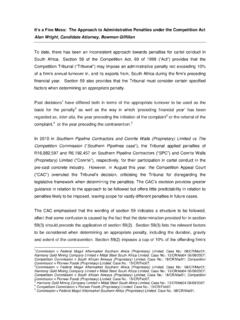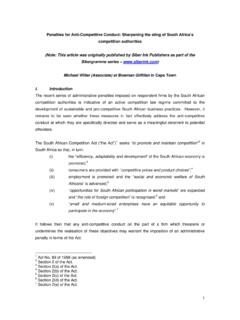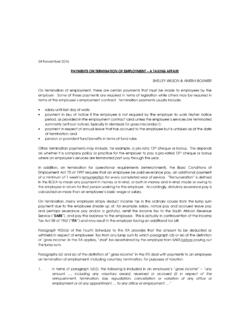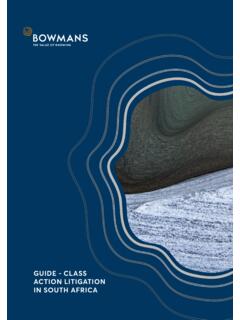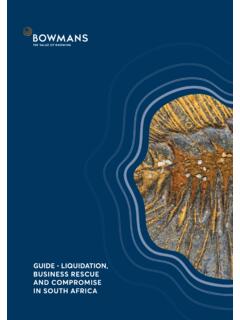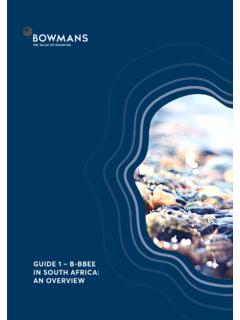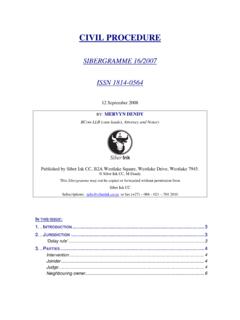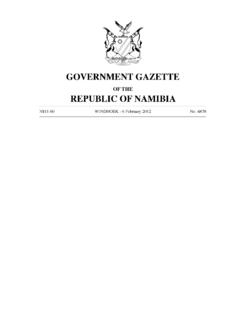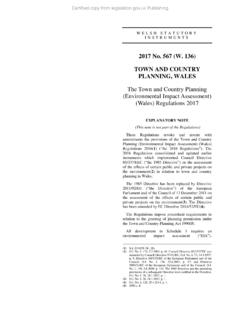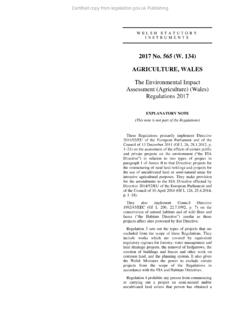Transcription of essential The 2017 changes to the EIA regulations 7 April ...
1 - 1 - 2017 Amendments To The environmental impact assessment Regulations_Tterblanche And The National environmental Management Act: 2017 amendments to the environmental impact assessment regulations Tina Terblanche and Melissa Strydom Introduction The National environmental Management Act 107 of 1998 (NEMA) requires that an environmental authorisation is obtained before activities, which have been listed in terms of NEMA, are commenced with. 1 The failure to obtain such an environmental authorisation, before commencing with listed activities, could result in administrative sanctions, including compliance notices or directives ordering the cessation of the operations until authorised; and fines of up to ZAR10 million for each such contravention.
2 2 The environmental impact assessment regulations (EIA regulations ) set out the process to be followed in applying for an environmental authorisation, while the listing notices, list the activities that require authorisation (the Listing Notices). Various versions of and amendments to the EIA regulations and Listing Notices have been published over the years, first published in 1997, 3 and thereafter in 2006, 2010 and 2014. 4 There have also been further amendments to specific listed activities during this period. Considering the many changes to the environmental authorisation regime over the years, one has to be careful to apply the law in effect at the time of the commencement of a listed activity.
3 In principle, laws do not operate retrospectively. Thus, it is essential to ensure that the correct version of the law is applied at the time of commencement of such an activity. A mistake in such an assessment could mean the difference between the activity being in compliance or non-compliance with the law, whether it is perceived or actual non-compliance. This could expose a business to significant risks. The 2017 changes to the EIA regulations The most recent changes to the environmental authorisation regime were published by the Minister of environmental Affairs on 7 April 2017.
4 5 These amendments appear to give further effect to the implementation of the One environmental System , being the agreement between the Ministers of Mineral Resources, environmental Affairs and Water Affairs and Sanitation on an integrated environmental management system for mining. 6 The generally accepted position being that the One environmental System took effect on 8 December 2014. 7 The High Court remarked that provisions giving effect to the One environmental System were confusing. 8 The 2017 amendments, through the transitional provisions, attempt to clarify the position post 8 December 2014 in respect of environmental authorisations and environmental Management Programmes (EMPrs) for mining.
5 The transitional provisions include that: If an environmental authorisation was required and obtained prior to 8 December 2014 in respect of mining activities, 9 and a mining right granted in terms of the Mineral and Petroleum Resources Development Act 28 of 2002 (MPRDA), the requirements of the NEMA had been met. Post 8 December 2014, EMPrs for mining activities, which were approved under the MPRDA, are now subject to the provisions of the EIA regulations . This includes that the first environmental audit 1 Section 24, 24D of NEMA. 2 Section 24F, 24G, 31L of NEMA.
6 3 In terms of the environmental Conservation Act 73 of 1989. 4 In terms of NEMA. 5 Government Notices 324 to 327 in Government Gazette 40772 of 7 April 2017. 6 Minutes of the meeting of the Portfolio Committee on environmental Affairs of the Implementation of the one environmental system in respect of mining activities held on the 14th of February 2017. The shift to an integrated system was necessitated by high costs, duplication of assessments and non-alignment of time periods for approval due to the separate approval processes under NEMA and the MPRDA, respectively. See T. Humby One environmental system : Aligning the laws on the environmental management of mining in South Africa (2015) 33(2) Journal of Energy and Natural Resources Law 111.
7 These problems posed unnecessary barriers to investment in the mining sector. 7 There is of course some debate on the exact date when considering the wording of the relevant Amendment Acts, including section 14 of Act 62 of 2008, the commencement of section 2 of Act 25 of 2008 or 49 of 2008 etc. In this regard see the explanation in Mineral Sands Resources (Pty) Ltd v Magistrate for the District of Vredendal, Kroutz NO and others [2017] 2 All SA 599 (WCC) particularly paragraph 21 read with footnote 1[A]. 8 Paragraphs 33 to 37 of Mineral Sands Resources (Pty) Ltd v Magistrate for the District of Vredendal and Others - Case No: 18701/16, referring to Regulation 54 of the 2014 EIA regulations .
8 9 We refer to mining activities generally, although it is in fact referred to as activities in terms of the Mineral and Petroleum Resources Development Act 28 of 2002 (MPRDA), which also includes prospecting or exploration, or extraction and primary processing, of a mineral or petroleum resource. - 2 - in respect of the EMPr must be submitted to the competent authority by 7 December 2019 and at least every five years thereafter. An aspect not currently covered by the EIA regulations transitional provisions is the status of an approved EMPr in relation to the requirements of section 5A(1) of the MPRDA, which requires an environmental authorisation prior to conducting mining activities.
9 The transitional aspects of the amendments of NEMA and the MPRDA, in giving effect to the One environmental System, have presented interpretational difficulties. The section of the MPRDA that provides that an EMPr approved in terms of the MPRDA is deemed to be approved, and is also considered to be an environmental authorisation in terms of NEMA, is not yet in effect. 10 Although the latter provision has not commenced it has been accepted that an EMPr approved prior to the One environmental System amendments, is considered an environmental authorisation. 11 An approved EMPr would thus be sufficient for purposes of section 5A(1) of the MPRDA.
10 See this article link, which discusses these aspects of the One environmental System further, including with reference to the recent National environmental Management Laws Amendment Bill which intends to clarify this. Some of the other changes to the EIA regulations include: 1. Protocol and minimum information requirements: The amendments include that the Minister may gazette protocols or minimum information requirements in respect of an application. 12 This amendment has been introduced in various sub- regulations , particularly in the regulations containing the criteria to be taken into account by competent authorities when considering applications.

